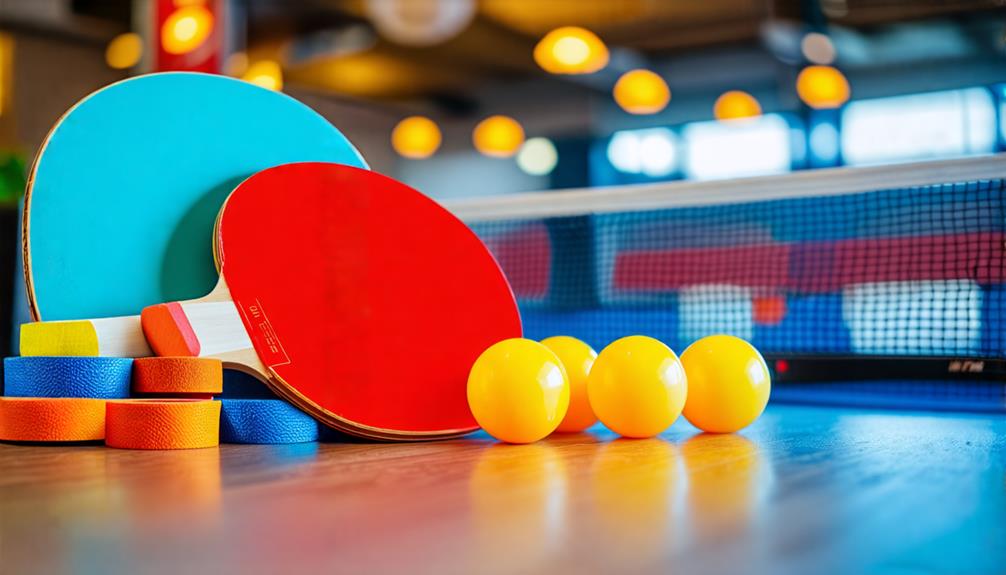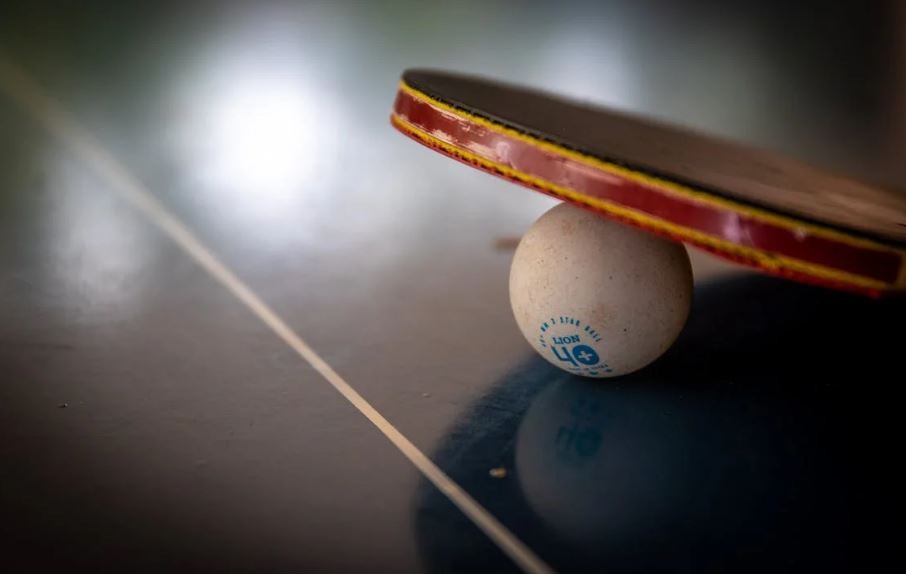What Size Room Is Needed for a Ping Pong Table?
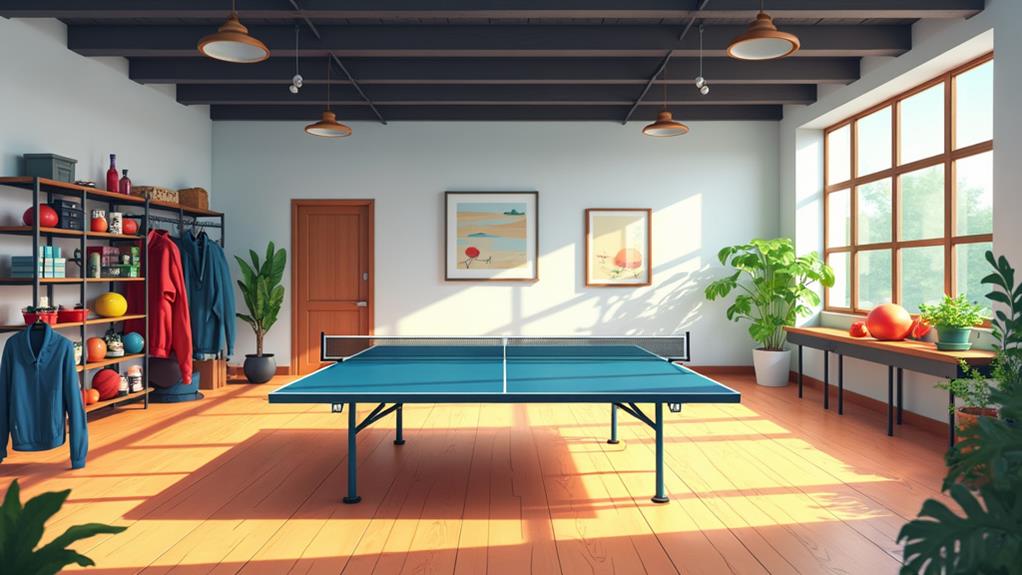
You'll need at least a 19 ft by 11 ft room to comfortably fit a standard ping pong table, which measures 9 ft by 5 ft. This space lets players move freely during the game. If you want a more dynamic play area, go for a room that's around 22 ft by 15 ft. Don't forget about ceiling height; aim for at least 10 ft to avoid any interference with your shots. For smaller spaces, consider compact tables that need less room, around 14 ft by 8 ft. Keep going to uncover more tips for finding the perfect setup!
Standard Ping Pong Table Dimensions
When pondering a standard ping pong table, you'll find that its dimensions are quite specific. A standard ping pong table measures 9 feet in length, 5 feet in width, and 2.5 feet in height, guaranteeing consistency and fairness in gameplay as per the International Table Tennis Federation (ITTF) regulations. Full-size table tennis tables are vital for official competitions, providing a uniform experience for all players.
To set up a standard ping pong table, you need to take into account the space around the table. Adequate playing space is fundamental for comfortable and effective gameplay. The minimum room size recommended is 19 feet in length and 11 feet in width. This allows players to move freely without constantly bumping into walls or furniture. However, the ideal room size is larger, measuring about 22 feet by 15 feet, providing ample space for more dynamic and competitive play.
If you have limited space, you might take into account a smaller ping pong table. These tables, measuring 7 feet by 4 feet or even 6 feet by 3 feet, can fit into tighter spaces while still providing a fun playing experience. Always verify the dimensions and available space to guarantee the best setup for your game.
Alternative Table Sizes
For those dealing with limited space, alternative table sizes offer a practical solution without sacrificing the joy of ping pong. Smaller table tennis options, like 7 ft by 4 ft or 6 ft by 3 ft tables, cater perfectly to tighter environments, making recreational play feasible even when space is at a premium. These compact tables are great for homes or apartments where standard-size tables simply can't fit.
When considering alternative table sizes, keep in mind the following benefits:
- Reduced Room Requirements: With smaller ping pong table dimensions, the room size you need shrinks to about 14 ft by 8 ft, ensuring you can play comfortably.
- Minimal Clearance Space: These tables need just 2 ft of clearance on the sides and 4 ft at the ends, maximizing your space available for other activities.
- Ideal for Beginners and Kids: Compact tables are accessible and enjoyable for beginners or children, making them a great enhancement to family homes.
- Enhanced Versatility: These tables can fit into different settings, from small living rooms to converted garages, offering flexibility in where you set up your game space.
Ideal Room Size
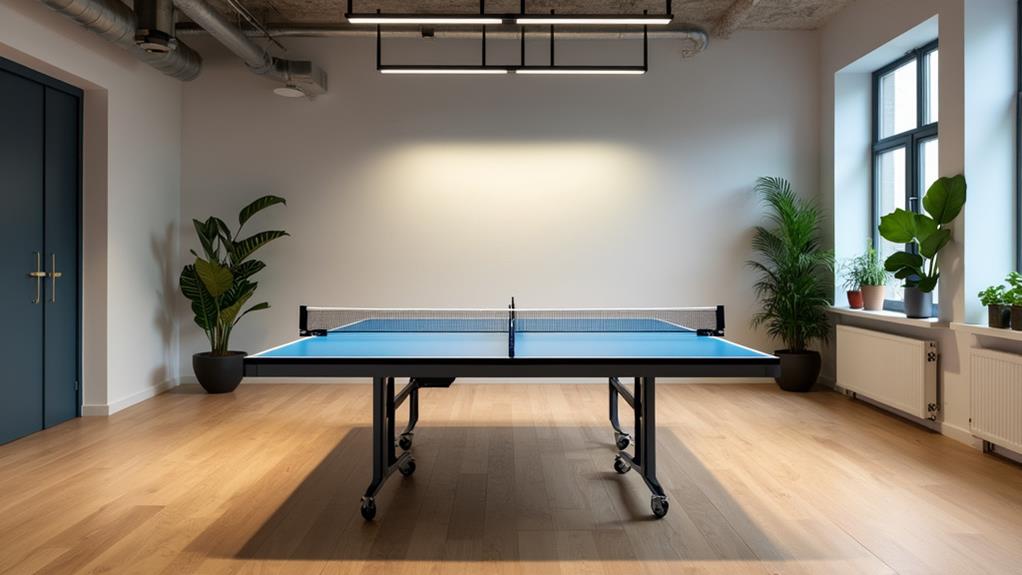
Finding the ideal room size for a ping pong table guarantees you have enough space for smooth, enjoyable gameplay. For a standard size table tennis setup, the minimum recommended room dimensions are 19 feet long by 11 feet wide. This space assures you have ample room to move around and play without feeling cramped.
Optimal play involves maintaining at least 3 feet of space on the sides of the table and 5 feet at each end. This buffer allows you to maneuver and make those winning shots without bumping into walls or furniture. If you're working with a smaller table, like one that's 7 feet by 4 feet, you can adjust the space to 2 feet on the sides and 4 feet at the ends.
For doubles games, the ideal space expands to 24 feet by 14 feet, accommodating the supplementary movement of two players per side. Don't forget about the vertical space; a ceiling height of at least 10 feet is recommended to avoid any disruptions from light fixtures or other overhead obstacles. By following these guidelines, you'll create the perfect environment for your table tennis matches.
Minimum Space Requirements
Setting up a ping pong table in your home requires careful planning to guarantee you've got enough room for comfortable play. The minimum space requirements are essential for ensuring you can enjoy the game without feeling cramped. A standard ping pong table size is 9 feet long and 5 feet wide, so you'll need adequate space around it for movement.
For ideal playing conditions, aim for a room that's at least 19 feet long and 11 feet wide. This provides the necessary 5 feet of clearance behind each end and 3 feet on each side. However, if space is tight, you can reduce the room length to around 17 feet, though this may affect play quality and shot execution.
Here are some key points to take into account:
- Minimum room size: 19 feet by 11 feet for comfortable play.
- Ideal space around the table: 5 feet behind each end, 3 feet on each side.
- Recreational play: A room size of about 22 feet by 11 feet for improved comfort.
- Ceiling height: At least 10 feet to avoid interference.
Ceiling Height Considerations
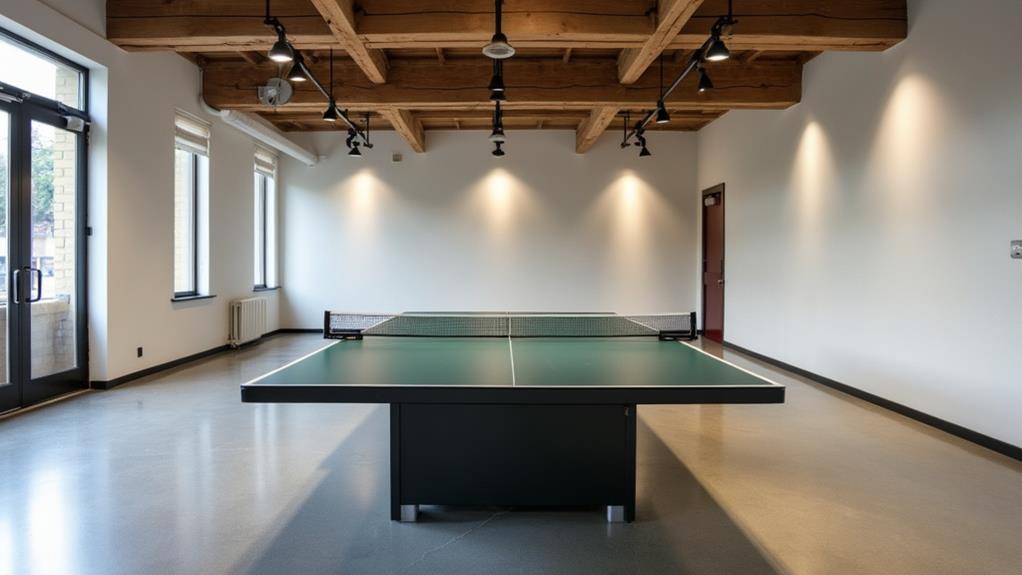
While making sure you have enough floor space is vital, don't overlook the significance of ceiling height when setting up your ping pong room. The minimum suggested ceiling height for ideal ping pong play is 10 feet. This height prevents interference from low-flying balls and allows you to make comfortable overhead shots without worrying about hitting the ceiling.
Having at least 10 feet of vertical clearance is fundamental not just for your gameplay but also for the safety and enjoyment of everyone involved. Insufficient clearance can hinder your ability to play effectively and might lead to accidental damage to light fixtures or ceiling decorations. So, it's significant to plan accordingly.
For an improved gameplay experience, especially if you're a competitive player, consider opting for even higher ceilings. Higher ceilings provide more room for advanced shots and maneuvers, allowing you to fully utilize a wide range of playing techniques. When planning your space, aim for at least 3 feet of vertical clearance above the table to guarantee that all players can enjoy the game without restrictions. By considering these factors, you can create a space conducive to both casual and competitive play.
Room Size for Doubles Play
When setting up a ping pong room for doubles play, having the right room size is essential for a comfortable and enjoyable experience. Ideally, you'll want a room that's about 24 feet long by 14 feet wide. This allows ample space around the table, making it easier for player movement and executing different shots.
- Adequate space around the table: Guarantees all players can move freely without bumping into walls or furniture.
- Comfortable playing environment: A larger room provides an enjoyable experience, free from cramped quarters.
- Safe distance: Reduces the risk of injury during intense, fast-paced matches.
- Experienced players: Benefit from larger room dimensions to perform advanced shots without hindrance.
If you're limited on space, the minimum space required for doubles play is 19 feet by 11 feet. However, this may feel tight and restrict player mobility. Guaranteeing a safe distance from walls and furniture is vital to prevent accidents and create a comfortable playing environment. Remember, larger room dimensions not only improve player movement but also make your complete ping pong experience much more enjoyable. So, plan wisely to accommodate the needs of all players involved in doubles play.
Outdoor Table Options
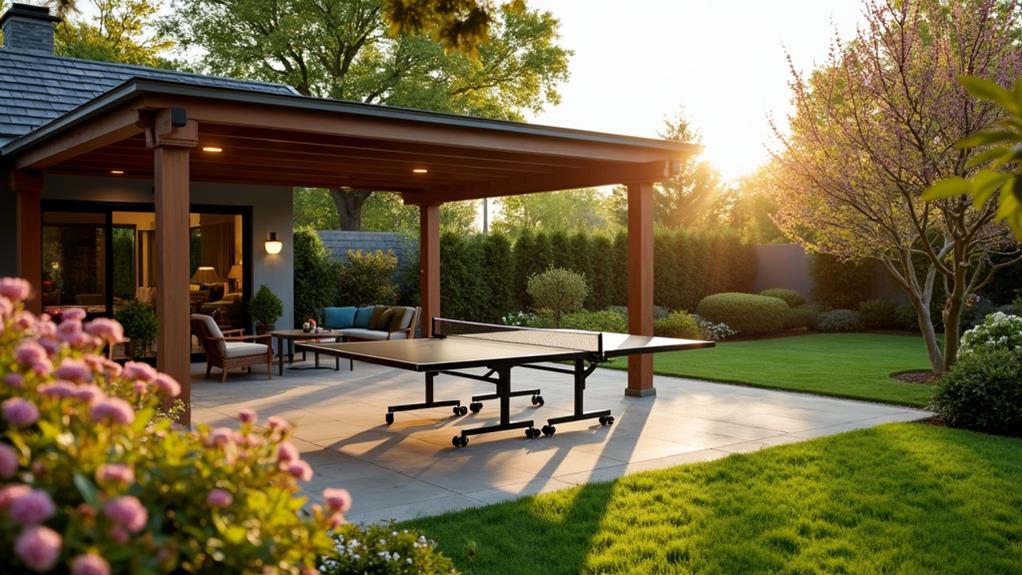
If you're looking to expand your ping pong experience beyond the confines of indoor play, consider outdoor table options. Outdoor table tennis tables are built with weather-resistant materials, allowing you to enjoy the game year-round without worrying about the elements. But how much space do you need? Just like indoor setups, you'd require a minimum area of at least 11ft x 19ft to play comfortably. This guarantees players can move freely around the table.
Additionally, it's essential to set up your table on a level ground surface. Uneven terrain can cause safety issues and affect the quality of your gameplay. Don't forget about the clearance above the table either; you'll need at least 3ft to avoid interference from overhead structures or trees.
Outdoor settings also introduce unique challenges. Wind and water are outdoor hazards that can impact the game's dynamics and the table's longevity. Keeping these in mind will help you create a more enjoyable playing environment. Many tables offer a playback position, allowing you to practice alone by folding one side up.
With these considerations, you can make the most out of your outdoor table tennis experience.
Choosing the Right Table
Choosing the right ping pong table involves more than just picking one that fits your space. You'll need to take into account several factors to guarantee a good fit and enjoyable gameplay. Start by knowing the standard size of a ping pong table, which is 9 ft long by 5 ft wide. This size requires a room with ample space around it for movement. If your room is smaller, you can look for alternatives like 7 ft by 4 ft or 6 ft by 3 ft tables, which cater to different room sizes.
Don't forget the height of the table, which is typically 2.5 ft. Make sure your ceiling height is at least 10 ft to avoid disrupting your table tennis game. The surface material, often MDF, is vital for durability and ball bounce quality.
Reflect on these points when choosing your table:
- Surface Material: MDF is durable and affects bounce quality.
- Table Size: Options range from 9 ft by 5 ft to smaller alternatives.
- Ceiling Height: Minimum clearance of 10 ft is recommended.
- Portability: Foldable tables are great for saving space when not in use.
Safety and Maintenance Tips
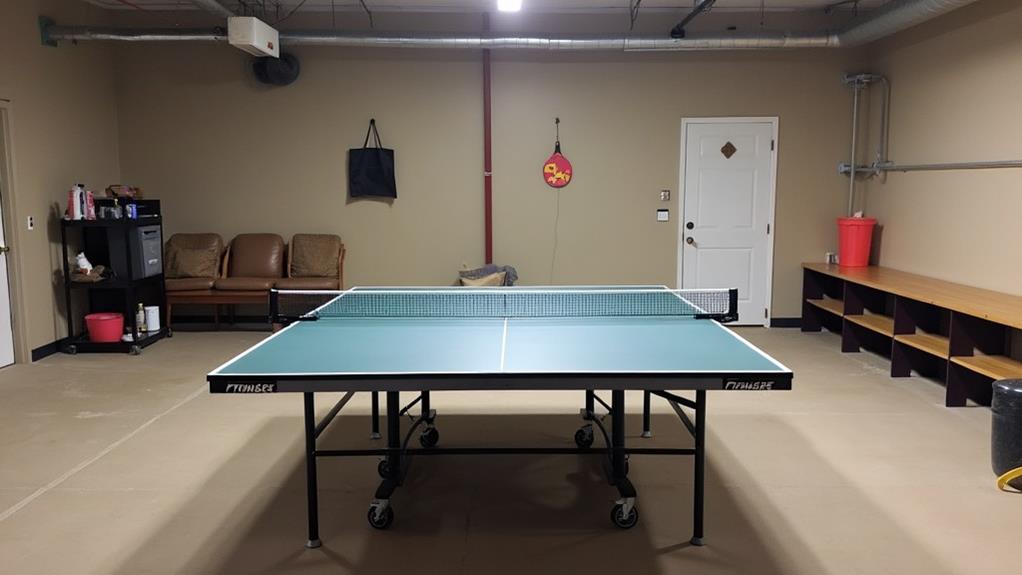
Safety and maintenance are vital for a long-lasting and enjoyable ping pong experience. Primarily, make certain your ping pong table is in a room with at least a 10-foot ceiling. This prevents interference from light fixtures and allows for unobstructed play. To enhance safety, especially if children are around, opt for tables with rounded corners. This simple feature can greatly reduce the risk of injury.
Stability is another important factor. If you have a foldable table, verify it has reliable locking mechanisms to prevent it from collapsing during gameplay. For added stability, place non-slip pads under the table legs to keep it from sliding during those intense matches. This will help maintain a safe playing environment and protect your floors.
When it comes to maintenance, always store your ping pong equipment safely out of children's reach. Supervise young players to make certain they handle the paddles and balls responsibly. Regularly check the table for any wear and tear, and tighten any loose parts to keep it in top condition. By following these safety and maintenance tips, you'll create a secure and enjoyable space for everyone to enjoy ping pong.
Additional Game Accessories
When improving your ping pong setup, supplementary game accessories often play an vital role in elevating your gameplay experience. The right equipment can make all the difference, regardless of whether you're a beginner or an advanced player. Important accessories like paddles, balls, and nets are critical for gameplay and should be selected based on your skill level and preferences.
- Paddles: High-quality paddles come with different rubber types and handle shapes, improving your grip and control. Choose paddles that match your playing style and comfort.
- Balls: Table tennis balls vary in size and weight, but the standard competition ball measures 40mm in diameter. Consistent ball quality guarantees a fair and enjoyable game.
- Practice Nets and Rebound Boards: These training aids are invaluable for solo practice, allowing you to perfect your shots and improve skills even without a partner.
- Storage Solutions: Keep your playing area tidy with paddle and ball holders. Organized storage guarantees your equipment is easily accessible and well-maintained.
Investing in these accessories improves your general gameplay, making each session more enjoyable and productive. Don't overlook these key components—they're vital for a thorough ping pong setup.
